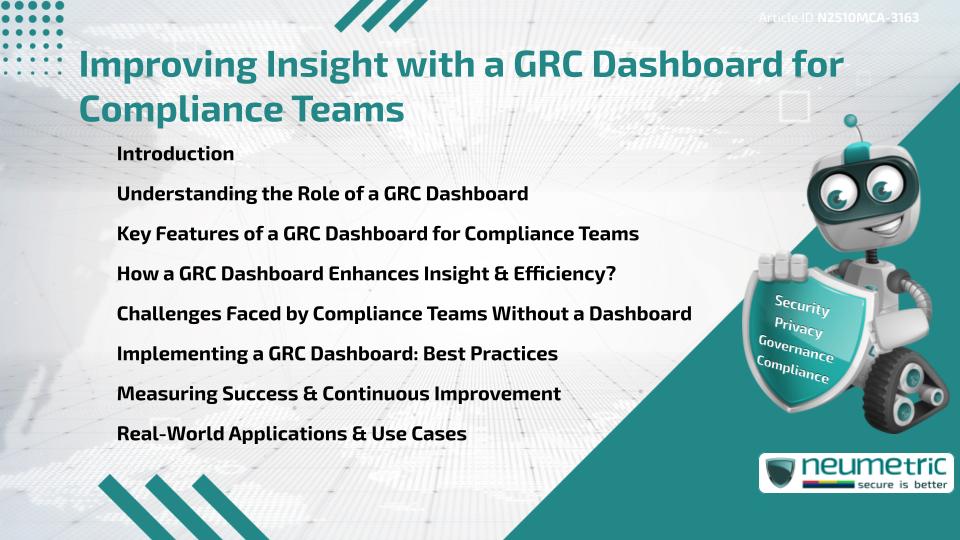Table of Contents
ToggleIntroduction
A GRC Dashboard for compliance teams is a unified platform that brings visibility, efficiency & accuracy to compliance operations. It integrates Governance, Risk & Compliance [GRC] data into a single view, helping Organisations identify Risks, track controls & measure compliance performance in real time. By centralizing data, automating reporting & supporting collaboration, a GRC Dashboard for compliance teams transforms complex regulatory tasks into actionable insights. This article explores how these Dashboards work, why they are essential & the Best Practices for using them effectively.
Understanding the Role of a GRC Dashboard
A GRC Dashboard for compliance teams serves as the central nervous system of Risk Management & compliance oversight. It aggregates information from different business units, departments & tools into one accessible interface.
Using visual indicators such as graphs, alerts & heatmaps, it allows compliance officers to quickly detect deviations, assess control effectiveness & ensure adherence to regulations like GDPR, HIPAA & ISO 27001.
In essence, a GRC Dashboard turns fragmented compliance data into an interactive visual story, enabling informed decisions at every level.
Key Features of a GRC Dashboard for Compliance Teams
Modern Dashboards provide a comprehensive suite of features that simplify oversight & monitoring. These typically include:
- Real-Time Risk Tracking: Updates metrics continuously, ensuring compliance officers respond quickly to potential issues.
- Automated Reporting: Generates & distributes reports based on configurable templates.
- Integrated Data Sources: Connects to policy management, Audit systems & Risk Assessment tools.
- Customizable Visuals: Tailors data displays to specific roles & responsibilities.
- Audit Trails: Maintains a clear history of actions & Evidence for accountability.
These features allow compliance teams to move from reactive compliance to proactive Governance.
How a GRC Dashboard Enhances Insight & Efficiency?
The biggest value of a GRC Dashboard for compliance teams lies in its ability to turn complexity into clarity.
Compliance leaders often juggle multiple Frameworks, such as SOX, ISO & NIST. Dashboards simplify this by displaying unified metrics & trend analysis that highlight where Risks concentrate.
For example, heatmaps can pinpoint departments with repeated Audit failures, while KPI indicators can track the number of closed vs. open issues. This clarity helps leadership allocate resources strategically & improve Risk posture.
Challenges Faced by Compliance Teams Without a Dashboard
Teams operating without a centralized Dashboard often face:
- Fragmented data & inconsistent reporting formats
- Delayed communication between departments
- Lack of transparency into control effectiveness
- Time-consuming manual report generation
- Difficulty proving compliance during audits
Without a GRC Dashboard for compliance teams, even small regulatory updates can trigger confusion & rework, leading to potential non-compliance penalties.
Implementing a GRC Dashboard: Best Practices
Adopting a GRC Dashboard for compliance teams requires thoughtful planning. Key steps include:
- Assess Existing Systems: Identify integration points across your current tools.
- Define KPIs: Determine what metrics truly represent compliance success.
- Involve Stakeholders Early: Gain input from Audit, legal & IT teams.
- Ensure Data Quality: Cleanse & standardize data before integration.
- Train Users: Conduct regular sessions to familiarize staff with Dashboard features.
Measuring Success & Continuous Improvement
To measure the success of a GRC Dashboard, Organisations can track indicators such as reduced Audit cycle time, fewer policy breaches & improved remediation rates.
Dashboards should not be static tools-they evolve as business priorities & regulations change. Periodic reviews ensure that metrics remain relevant & aligned with strategic goals.
Continuous Improvement keeps the Dashboard useful & aligned with compliance maturity.
Real-World Applications & Use Cases
Companies across industries use a GRC Dashboard for compliance teams to enhance operational efficiency.
- Healthcare providers monitor HIPAA compliance & incident trends.
- Financial institutions track anti-money laundering [AML] alerts & reporting status.
- Manufacturers ensure supplier & safety compliance.
In each case, Dashboards simplify oversight, highlight priorities & strengthen Governance culture across departments.
Takeaways
A GRC Dashboard for compliance teams is more than a reporting tool-it is a strategic asset that improves visibility, accountability & decision-making. It saves time, ensures consistent communication & provides a single version of truth for compliance operations. Implementing one effectively can transform an organisation’s ability to manage regulatory demands efficiently.
FAQ
What is a GRC Dashboard?
A GRC Dashboard is a centralized tool that displays Governance, Risk & Compliance data in real time, helping Organisations track regulatory status & control performance.
Why do compliance teams need a Dashboard?
It provides instant visibility into compliance metrics, streamlines reporting & helps identify potential Risks early.
How does it improve compliance accuracy?
By consolidating data from multiple systems, it eliminates manual errors & ensures reports reflect current information.
Can small Organisations use a GRC Dashboard?
Yes. Scalable Dashboard tools are available for Organisations of all sizes, offering flexibility based on need & budget.
What metrics should be tracked?
Common metrics include control effectiveness, Audit Findings, Risk severity & compliance completion rates.
How often should Dashboards be updated?
Ideally, Dashboards should refresh in real time or daily to reflect accurate compliance conditions.
What are common mistakes in Dashboard implementation?
Overloading Dashboards with unnecessary metrics, neglecting data quality & ignoring User feedback can undermine effectiveness.
Need help for Security, Privacy, Governance & VAPT?
Neumetric provides organisations the necessary help to achieve their Cybersecurity, Compliance, Governance, Privacy, Certifications & Pentesting needs.
Organisations & Businesses, specifically those which provide SaaS & AI Solutions in the Fintech, BFSI & other regulated sectors, usually need a Cybersecurity Partner for meeting & maintaining the ongoing Security & Privacy needs & requirements of their Enterprise Clients & Privacy conscious Customers.
SOC 2, ISO 27001, ISO 42001, NIST, HIPAA, HECVAT, EU GDPR are some of the Frameworks that are served by Fusion – a SaaS, multimodular, multitenant, centralised, automated, Cybersecurity & Compliance Management system.
Neumetric also provides Expert Services for technical security which covers VAPT for Web Applications, APIs, iOS & Android Mobile Apps, Security Testing for AWS & other Cloud Environments & Cloud Infrastructure & other similar scopes.
Reach out to us by Email or filling out the Contact Form…


